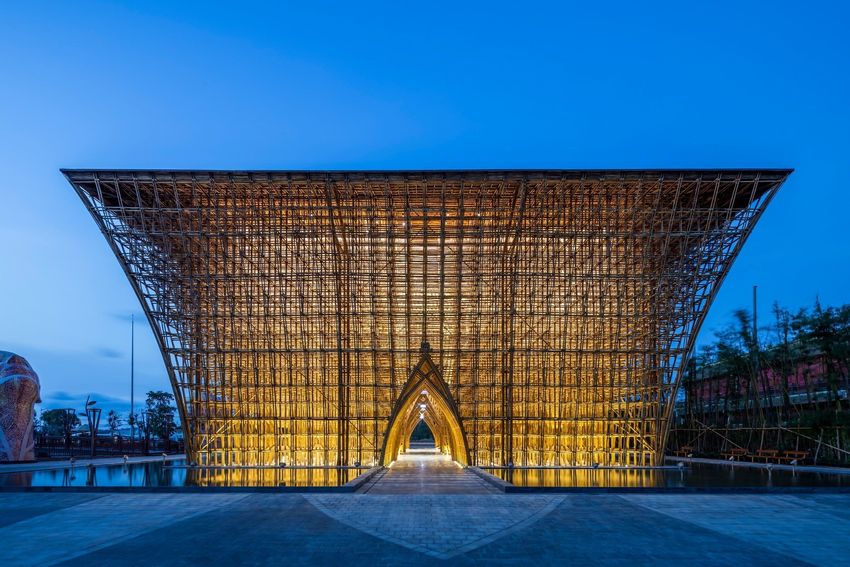Introduction
Imagine a building material that’s as strong as steel, more sustainable than concrete, and grows faster than any tree. Sounds too good to be true? Meet bamboo—nature’s green steel. This versatile, eco-friendly material is transforming the construction industry, offering strength, flexibility, and sustainability. From traditional homes in Asia to modern skyscrapers and eco-friendly resorts, bamboo is proving to be a game-changer. In this article, we’ll explore how bamboo works, its benefits, and why it’s becoming the future of construction. 🎋🏡🌍
🧠 What Makes Bamboo Special?
Bamboo is a fast-growing grass that can reach maturity in just 3 to 5 years, compared to decades for traditional hardwoods. Despite its lightweight nature, bamboo boasts an impressive tensile strength—the ability to resist being pulled apart—comparable to steel. Its natural flexibility makes it earthquake-resistant, while its hollow structure keeps it lightweight yet strong.
Key Characteristics of Bamboo:
- ⚡ High Tensile Strength: Comparable to steel, ideal for structural support
- 🌱 Fast Growth: Matures in 3-5 years, making it highly renewable
- 🌍 Eco-Friendly: Absorbs CO₂ and releases oxygen, reducing carbon footprints
- 💪 Durable and Flexible: Withstands heavy loads and resists earthquakes
- 💧 Moisture-Resistant: Naturally resistant to moisture, pests, and fungi when treated properly
📜 A Brief History of Bamboo in Construction
Bamboo has been used in construction for thousands of years, especially in Asia, South America, and Africa. Ancient Chinese, Indian, and Japanese cultures used bamboo for bridges, homes, and scaffolding due to its strength and availability. Today, modern architects and engineers are rediscovering bamboo’s potential, blending traditional craftsmanship with innovative design.
🏗️ How Bamboo Is Used in Modern Construction
-
Structural Framework:
- Bamboo poles are used as beams, columns, and trusses, providing strong structural support.
- Example: The Green School in Bali, an award-winning sustainable school built almost entirely from bamboo.
-
Flooring and Walls:
- Bamboo planks are used for flooring, walls, and ceilings, offering a natural and aesthetically pleasing finish.
- Example: Bamboo flooring is popular in eco-friendly homes due to its durability and beauty.
-
Roofing:
- Bamboo shingles and tiles provide lightweight yet durable roofing solutions.
- Example: Traditional Asian homes use bamboo roofs that are both weather-resistant and breathable.
-
Bridges and Scaffolding:
- Bamboo’s strength and flexibility make it ideal for bridges and scaffolding in construction projects.
- Example: In Hong Kong, bamboo scaffolding is still used for skyscraper construction.
-
Decorative Elements:
- Bamboo is used for furniture, partitions, and decorative panels, adding a natural touch to interiors.
- Example: Bamboo furniture is popular for its durability, lightweight nature, and aesthetic appeal.
💪 Why Bamboo Is the Perfect Building Material
✅ 1. Strength and Durability:
- Bamboo’s tensile strength rivals that of steel, while its compressive strength is comparable to concrete.
- Its natural flexibility makes it resistant to earthquakes and strong winds.
🌱 2. Sustainability and Eco-Friendliness:
- Bamboo is one of the fastest-growing plants, maturing in just 3-5 years.
- It absorbs more CO₂ and releases more oxygen than most trees, reducing carbon footprints.
- Bamboo can be harvested without killing the plant, allowing it to regrow naturally.
💰 3. Cost-Effectiveness:
- Bamboo is cheaper than steel and concrete, reducing construction costs.
- Its lightweight nature lowers transportation and labor costs.
🌍 4. Low Environmental Impact:
- Bamboo requires minimal water, pesticides, and fertilizers to grow.
- It’s biodegradable and can be recycled or composted at the end of its life cycle.
💡 5. Aesthetic Appeal:
- Bamboo’s natural texture and warm color add beauty to both traditional and modern architecture.
- It blends seamlessly with natural environments, making it ideal for eco-resorts and sustainable homes.
🌱 Sustainability Benefits of Bamboo Construction
-
Carbon Sequestration:
- Bamboo absorbs large amounts of carbon dioxide and releases oxygen, helping combat climate change.
-
Reduced Deforestation:
- Using bamboo reduces the demand for timber, helping preserve forests and biodiversity.
-
Minimal Waste:
- Almost every part of the bamboo plant can be used, reducing construction waste.
-
Energy Efficiency:
- Bamboo construction requires less energy than steel or concrete, lowering carbon emissions.
-
Renewable Resource:
- Bamboo regenerates quickly, making it a sustainable alternative to slow-growing hardwoods.
🌍 Real-World Examples of Bamboo Architecture
🏫 1. The Green School, Bali:
- A world-renowned eco-school built almost entirely from bamboo, demonstrating its strength and beauty.
🌿 2. Bamboo Sports Hall, China:
- An award-winning sports facility that showcases bamboo’s structural capabilities.
🏡 3. Bamboo Eco-Resorts, Costa Rica:
- Luxury resorts built with bamboo to blend harmoniously with their natural surroundings.
🌉 4. Bamboo Bridges in China and India:
- Traditional bamboo bridges have stood the test of time, showcasing bamboo’s strength and durability.
🏛️ 5. Bamboo Pavilion, Expo 2010, Shanghai:
- A modern architectural masterpiece demonstrating bamboo’s potential in large-scale construction.
🧩 Comparing Bamboo to Traditional Building Materials
| Material | Tensile Strength | Compressive Strength | Growth Time | Environmental Impact | Cost |
|---|---|---|---|---|---|
| 🌱 Bamboo | High (like steel) | High (like concrete) | 3-5 years | Low (carbon-negative) | Low |
| 🪵 Wood | Medium | Medium | 20-50 years | Moderate (deforestation) | Medium |
| 🧱 Concrete | Low | Very High | N/A | High (carbon emissions) | Medium-High |
| 🏗️ Steel | Very High | High | N/A | High (energy-intensive) | High |
🛠️ Challenges of Using Bamboo in Construction
-
Durability and Maintenance:
- Untreated bamboo is vulnerable to moisture, insects, and fungi.
- Proper treatment (such as boron solutions) enhances its durability and lifespan.
-
Standardization and Regulations:
- Building codes and regulations often do not account for bamboo, limiting its use in some regions.
-
Fire Resistance:
- Bamboo is flammable, but modern treatments can improve its fire resistance.
-
Perception and Acceptance:
- Some people still view bamboo as a “poor man’s material,” despite its proven strength and beauty.
-
Supply Chain and Scalability:
- Large-scale bamboo construction requires reliable supply chains and skilled labor.
🌱 The Future of Bamboo Construction
As sustainability becomes a global priority, bamboo is poised to play a key role in the future of construction. Innovations in treatment, design, and engineering are expanding bamboo’s applications, from skyscrapers and bridges to modular homes and temporary shelters. Governments and architects are increasingly recognizing bamboo’s potential to reduce carbon footprints, combat deforestation, and create affordable, eco-friendly housing.
Emerging Trends:
- Bamboo Skyscrapers: Architects are exploring bamboo as a structural material for high-rise buildings.
- Modular Bamboo Homes: Prefabricated bamboo homes offer affordable and sustainable housing solutions.
- Bamboo Composite Materials: Bamboo fibers are being combined with resins to create stronger, more durable construction materials.
- Green Building Certifications: Bamboo is gaining recognition in green building programs like LEED and BREEAM.
🌍 Why Bamboo Is the Future of Sustainable Construction
✅ Eco-Friendly: Reduces carbon emissions and deforestation
✅ Renewable: Fast-growing and easily replenished
✅ Affordable: Cheaper than steel and concrete
✅ Strong and Flexible: Withstands heavy loads and earthquakes
✅ Versatile: Suitable for homes, bridges, furniture, and skyscrapers
As countries strive to meet sustainability goals and reduce their carbon footprints, bamboo offers a natural solution that’s both practical and beautiful. Whether building eco-resorts, affordable housing, or modern skyscrapers, bamboo is proving that sustainability and strength can go hand in hand.
📝 Conclusion
Bamboo is no longer just a traditional building material—it’s a symbol of sustainable innovation. With its impressive strength, rapid growth, and eco-friendly properties, bamboo is transforming the construction industry and paving the way for a greener future. As architects and engineers continue to push the boundaries of bamboo design, this humble grass is set to become the cornerstone of modern, sustainable architecture. So the next time you see a bamboo building, remember—you’re looking at the future of construction! 🎋🏗️🌱😊


